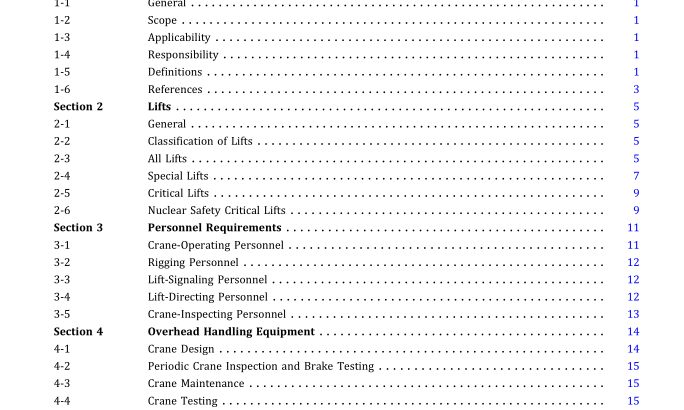ASME NML-1-2019 pdf free download.Rules for the Movement of Loads Using Overhead Handling Equipment in Nuclear Facilities
multiple fuel assemblies such that nuclear reactivity cannot increase. facility acceptable excursion limit (FAEL): the distance a load can move where its movement remains safe.
This limit applies to any hoist or travel motion when uncom- manded load movementoccurs.
Itis intended to assume a mechanical or a control system failure has occurred and manual or automatic systems must be used to stop the load. infrequently performed test and evolution (IPTE): infre- quentlyperformed testor evolution thathas the potential to significantly degrade the plant’s margin of safety and therefore warrants additional managementoversightand control. intermediate hoist: an additional hoist that is used as part oftheriggingbelowthe primaryhoist. Itcouldbeusedas a means ofleveling the load or as a more precise means of lifting the load. lift, critical: any lift that carries a high risk of a load-han- dlingevent,asdeterminedbythepresenceofcertainprobability factors and the severity of the possible consequences of such an event.
lift, nuclear safety critical: any lift, performed in a given area after a plant becomes operational, in which the load weighs more than the combined weight of a single spent fuel assemblyand its associated handling tool for the spe- cific plant in question that, as a result of uncontrolled motion exceeding the movement safety envelope, can result in the loss of an essential safety function.
Nuclear safety critical lifts are a subset of critical lifts.
lift, special: any lift that carries a moderate risk ofa load- handling event, as determined by the presence ofcertain probability factors and the severity ofthe possible conse- quences of such an event. lift, standard: any lift that carries a low risk ofa load-han- dlingevent,asdeterminedbythepresenceofcertainprob- ability factors and the severity of the possible consequences of such an event.
liftingevolution:the lifting,transporting, andsettingdown ofany load. Lifting and setting down the load in the same location for a rigging adjustment does not constitute a lifting evolution.
load-handlingevent: an unplannedand undesirable occurrence duringthe movementofa crane or its load thatmay have a negative effect on operations. loadtest, return-to-service: atestthatproves the adequacy of the equipment being tested to lift and hold a load.
may: word used to denote permission, which is neither a requirement nor a recommendation.
minimum liftheight: the smallestdistance thata load must be lifted above a surface in order for the crane’s safety features to engage and stop the load should the hoist fail to hold the load. This calculation shall evaluate factors such as wire rope stretch, time to detect uncommanded lowering, brake response time, energy dissipa- tion, and additional distance needed as a safety margin.
Mitigating Systems Performance Index: performance indicator for five nuclear power plant emergency systems: emergency AC power, high-pressure injection, heat removal, residual heat removal, and support cooling. movementsafetyenvelope: the additional volume arounda given crane, load, and rigging configuration that accounts forthe detection and mitigation ofunintended movement. Thisenvelopeislessthanorequaltothefacilityacceptable excursion limit (FAEL) established for the crane design. OEM: original equipment manufacturer. overhead handling equipment: permanent cranes, temporary cranes, mobile cranes, and manually operated hoistingequipmentthatare used to hoistaload orto hoist and move a load from one location to another. owner: the organization legally responsible for the construction and/or operation of a nuclear facility, including but not limited to one who has applied for or been granted a construction permit or operating license by the regulatory authority having lawful jurisdiction. planned engineered lifts: lifts in excess of the rated load that are required from time to time on a limited basis for specific purposes such as new construction or major repairs.
predictive maintenance: the use of techniques such as thermal, vibration, and lubrication analyses to predict the service life of a component or system. preventive maintenance: maintenance techniques imple- mented to ensure safe and reliable operation ofoverhead handling equipment.
qualified person: a person who by possession of a recog- nizeddegreeinanapplicablefieldoracertificateofprofes- sional standing, or by extensive knowledge, training, and experience, has successfully demonstrated the ability to solve problems related to the subject matter and work. redundantlifting device: a lifting device that provides two independent lifting paths, each capable of carrying the load.
risk:thecombinationoftheprobabilityofanoccurrenceof an undesirable event and the severity ofthe consequence of that event.ASME NML-1 pdf download.ASME NML-1-2019 pdf free download
